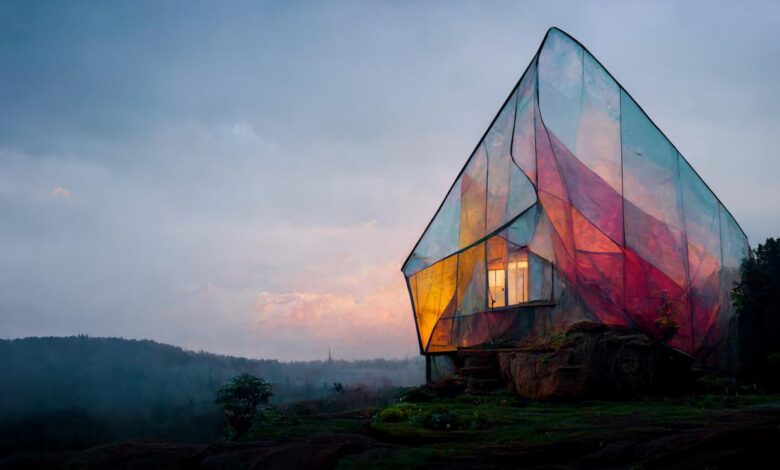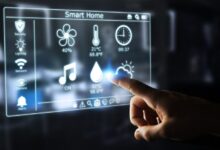Building a Home with AI Creates Human-Centric Future

The world of architecture and construction is on the cusp of a profound transformation, one driven by the power of artificial intelligence (AI). What was once a human-centric, labor-intensive process is rapidly evolving into a data-driven, intelligent, and highly efficient system. AI is no longer a futuristic concept for a few high-tech projects; it is becoming an indispensable tool for every stage of building a home, from the initial design and material selection to the construction and long-term maintenance. This article will take a deep dive into the core concepts of building a home with AI, exploring the pivotal role of generative design, the power of predictive analytics, the new focus on a home as a hub for wellness, and the immense opportunities and challenges that lie ahead for a more sustainable, resilient, and human-centric future.
AI in Architectural Design

The traditional process of architectural design, which can take months or even years, is being revolutionized by AI. The new era is defined by a collaborative process where a human architect and an AI work together to create a more innovative, efficient, and sustainable design.
A. The Power of Generative Design
Generative design is an AI-powered process that uses a set of user-defined parameters—such as a budget, a location, or a list of desired features—to generate hundreds or even thousands of design options in a matter of seconds. This is a game-changer for architecture, as it allows a human architect to explore a wide range of possibilities that would be impossible to create with a traditional design process.
- Optimized Layouts: AI can analyze a home’s location, its natural light, and its surrounding landscape to create an optimized layout that maximizes natural light, minimizes energy consumption, and provides the best possible views.
- Material Selection: AI can analyze a homeowner’s budget and desired aesthetic to recommend a variety of materials that are not only beautiful but also sustainable and energy-efficient.
- Climate Resilience: AI can analyze a home’s location and its local weather patterns to create a design that is more resilient to extreme weather events, such as a hurricane, an earthquake, or a flood.
By using generative design, an architect can create a home that is more beautiful, more efficient, and more sustainable than a home designed with a traditional process.
B. The New Era of Smart Building Materials
The new era of building a home with AI is also a new era of smart building materials. AI is being used to design, test, and manufacture a new generation of materials that are more durable, more sustainable, and more intelligent than the traditional ones.
- Self-Healing Concrete: A new generation of concrete is being developed with the ability to self-repair. AI can be used to design a concrete that is embedded with a a certain type of bacteria that can produce calcium carbonate to fill cracks. This can significantly reduce maintenance costs and extend the lifespan of a home.
- Modular and Prefabricated Components: The use of modular and prefabricated components is a new and powerful trend in future-proof home design. AI can be used to design and optimize the layout of a modular home, and it can be used to control the robots that build the modules in a factory. This reduces waste, cuts down on construction time, and makes a home more resilient and more energy-efficient.
- Smart and Adaptive Materials: The future of building with AI will be defined by the use of smart and adaptive materials that can respond to the environment. This includes materials that can change their color or transparency to control light and heat, or materials that can self-repair to reduce maintenance costs.
A New Kind of Living
A home built with AI is an intelligent home, a home that is equipped with a new generation of smart technology that can adapt to the needs of its occupants and the challenges of tomorrow.
A. The Power of Building Automation and AI
The new generation of smart home technology is powered by artificial intelligence. AI can automate a wide range of tasks, from adjusting the temperature to turning off the lights, and it can learn a homeowner’s habits and preferences to create a more personalized and comfortable living experience.
- Centralized Control: A smart home can be controlled from a single device or a smartphone app. This allows a homeowner to control everything from the lighting and temperature to the security system and the entertainment system from anywhere in the world.
- Predictive Maintenance: AI-powered systems can analyze a home’s data to predict when a system, such as an HVAC unit or a water pump, is likely to fail. This allows a homeowner to schedule maintenance proactively, preventing a costly and unscheduled breakdown.
- Personalized and Adaptive Environments: An AI-powered smart home can learn a homeowner’s habits and preferences and then adapt the home’s environment to them. The smart home can, for example, learn a homeowner’s favorite temperature and automatically adjust the thermostat to that temperature when they are home.
B. A Home as a Hub for Wellness
The new era of building a home with AI is also a new era of wellness. A home is not just a place to live; it’s a hub for health, fitness, and a balanced lifestyle.
- Air and Water Quality Monitoring: A smart home can monitor the quality of the air and water, and it can alert a homeowner to any potential health risks. This is a crucial component of a home as a hub for wellness, as it ensures that the home’s environment is healthy and safe.
- Integrated Fitness and Health Technology: A smart home can be a hub for a person’s health and fitness. A smart home can, for example, be equipped with a smart mirror that can provide a personalized workout, or a smart bed that can monitor a person’s sleep and provide a detailed analysis of their rest.
- Biophilic Design: The use of biophilic design, which integrates nature into a home’s design, is a new and powerful trend in building a home with AI. The use of natural light, natural materials, and indoor plants can have a significant positive impact on a person’s mental and physical health.
The Future of Construction

The most labor-intensive part of building a home is the construction process itself. AI and robotics are poised to revolutionize this process, making it safer, more efficient, and more precise.
A. The New Workforce
The new era of construction will be a collaborative process between human builders and a new generation of robots and cobots (collaborative robots).
- Robotic Bricklayers: Robots can now lay bricks with a level of speed and precision that is impossible for a human. This can reduce the time it takes to build a home’s walls and it can reduce the risk of injury for a human worker.
- Autonomous Construction Vehicles: Autonomous construction vehicles, such as autonomous bulldozers and excavators, are being used to perform a wide range of tasks on a construction site. This can reduce the need for a human driver and can increase a project’s speed and efficiency.
- Cobots: Cobots are being used to assist human builders with a wide range of tasks, from lifting heavy materials to performing intricate assembly work. This can reduce the risk of injury for a human worker and can increase a project’s speed and efficiency.
B. The Power of Predictive Analytics
AI can analyze a construction project’s data to predict a wide range of outcomes.
- Project Management: AI can analyze a project’s schedule, its budget, and its resource allocation to predict a potential delay or a cost overrun. This allows a project manager to take a proactive rather than a reactive approach to a project’s management.
- Safety and Risk Management: AI can analyze a construction site’s data to predict a potential safety risk. A camera with AI-powered analytics can, for example, detect a person who is not wearing a helmet and alert a site manager. This can significantly reduce the risk of injury on a construction site.
- Quality Control: AI-powered cameras on a construction site can use edge computing to analyze a project’s quality in real-time, identifying defects and ensuring a high level of quality.
The Road Ahead
While the future of building a home with AI is bright, there are significant challenges that must be addressed to ensure that this revolution is inclusive and sustainable.
A. The Cost of Implementation
The cost of building a home with AI, particularly a net-zero home with all the latest smart technology and autonomous construction vehicles, can be prohibitive. The components that power these homes are expensive, creating a new digital divide between those who can afford a high-end home and those who cannot. The use of modular and prefabricated components is a major step toward addressing this, but more work is needed to make a home built with AI accessible to everyone.
B. The Evolving Legal and Regulatory Framework
The new era of building a home with AI is advancing faster than the laws that govern it. New regulations are urgently needed to address a wide range of issues, from the legal status of a robot on a construction site to the rights of a homeowner whose home is connected to a smart grid. The lack of a clear regulatory environment is a major barrier to adoption for many developers and cities.
C. The Human Element
A home is, at its core, a place for people. While technology can solve many problems, it cannot replace the human element of empathy, community, and social connection. The challenge is to use technology to enhance human interaction, not to replace it. Home design must be human-centric, creating spaces that foster community and belonging.
Conclusion
The future of building a home with AI is not a passing trend but a powerful and transformative movement that is fundamentally reshaping our relationship with our homes and with the environment. It is a testament to the power of a data-driven, holistic, and proactive approach to home design and construction. The use of generative design is creating more innovative, efficient, and sustainable designs than ever before. The use of AI and robotics in construction is making the process safer, more efficient, and more precise. The new era of building a home with AI is a clear signal that the future of home design is a new kind of living, a living that is as adaptable and as resilient as it is intelligent and sustainable.
However, as we embrace this new era, we must also confront the significant challenges that lie ahead. The high cost of a home built with AI, the need for a new legal and regulatory framework, and the challenges of data privacy and security are all hurdles that must be addressed proactively. The future of home design is a journey that will be defined not just by its technological prowess but by its ability to create a world that is more connected, more human-centric, and more conducive to a person’s overall well-being. The home built with AI is here, and it promises to build a future where our homes are as healthy and as happy as we are.

